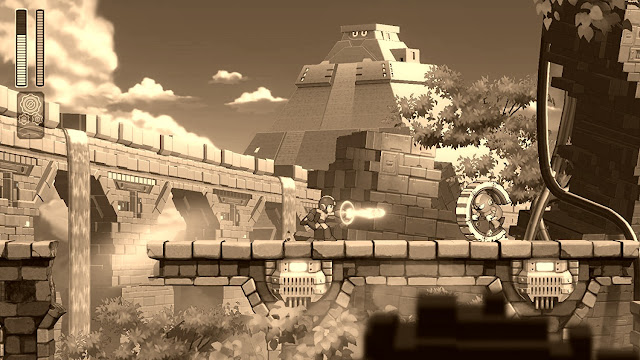Mega Man 11
Note: I played on the hardest difficulty setting.
I can see where Capcom was going with this. Play through the levels, and buy items in Dr. Light's shop with your hard earned bolts to help you prepare for each journey. There's a reason why Mega Man 11 features the longest levels in the franchise. The idea is to carefully consider what to invest on and what is more necessary for your journey, which should invite to a mental involvement with the game. It should be a huge cost to pay and you could lose it all in a game over.
The problem is that Capcom somehow didn't consider how this would repercute on the player's behavior. Because enemies respawn, and there's always a chance to find bolts after destroying any enemy, it's very easy for any player to just start farming for them, and the result is that the tension of what should a player invest in disappears, since they can just buy everything at the shop after some sessions of collecting materials. Nothing in the game stops you from doing so. It's like grinding in a JRPG. It makes the intended design fall apart. However, even if we disregard this exploit, Mega Man 11 shows serious design oversights in its intended game experience.
Allow me to illustrate this: An extra life costs 40 bolts (50 after some levels), and an extra energy tank costs 80 bolts (100 after some levels). An item that quadruples your defense costs 100. Each of the earliest levels gave me around 1000 bolts. In Tundra Man's stage, I got around 3000 there alone. After wondering why this happened, I looked up how many bolts I was receiving per drop, and they were 10 in the smallest drops, and 100 in the bigger ones approximately. If the game really intended to make the player feel that they're preparing for a journey, this generosity feels like a counterproductive measure, and instead is condescension to make the player not feel like they didn't accomplish anything and need to improve to overcome the challenges, like the original games expected from them.
All of this is important because it causes a snowball effect. Enemy damage is moderately high, but it doesn't matter much because you can heal with your energy tanks, or you can just die and try again, and trudge with brute force, instead of perceiving each level as a journey on its own right. Because you won't be using every resource you have bought, you will invest less and less in surviving, and more in those upgrades that make you even stronger. I had three Robot Masters left after I used everything I earned in Tundra Man's stage to get every upgrade I needed, and had capped pretty much everything. I never got a game over and was able to defeat every boss in my first serious attempt after the first stage.
This game feels like a project to save the Mega Man franchise in its 30th anniversary, but I don't think it captures the feeling of the original games. When I replayed Mega Man 1 a few years ago, even when I didn't find it as difficult as I did as a child anymore, I still had tension of losing my progress in a level. Everything I see here now is a game afraid of the series's past to fit in the landscape of modern gaming, which is probably more coward than being a nostalgic celebration.




Comments
Post a Comment